Film Studies: Color Symbolism and Auteur Theory in Shyamalan's Films
VerifiedAdded on 2022/11/04
|7
|1670
|268
Essay
AI Summary
This essay delves into the realm of film studies, focusing on the auteur theory and its application to the works of M. Night Shyamalan. The paper examines Shyamalan's distinctive directorial style, particularly his use of color symbolism as a key visual cue. The analysis centers on two of his prominent films, "The Sixth Sense" and "Unbreakable," demonstrating how specific colors are employed to enhance the narrative, create visual interest, and influence the audience's perception. The essay highlights how red signifies impending events in "The Sixth Sense" and how green and purple distinguish protagonists and antagonists in "Unbreakable." By exploring these examples, the essay underscores the importance of color symbolism in Shyamalan's films, contributing to their overall impact and thematic depth. The conclusion reinforces the thesis, emphasizing the director's ability to use color to shape the visual tone and guide the audience's interpretation of the scenes.
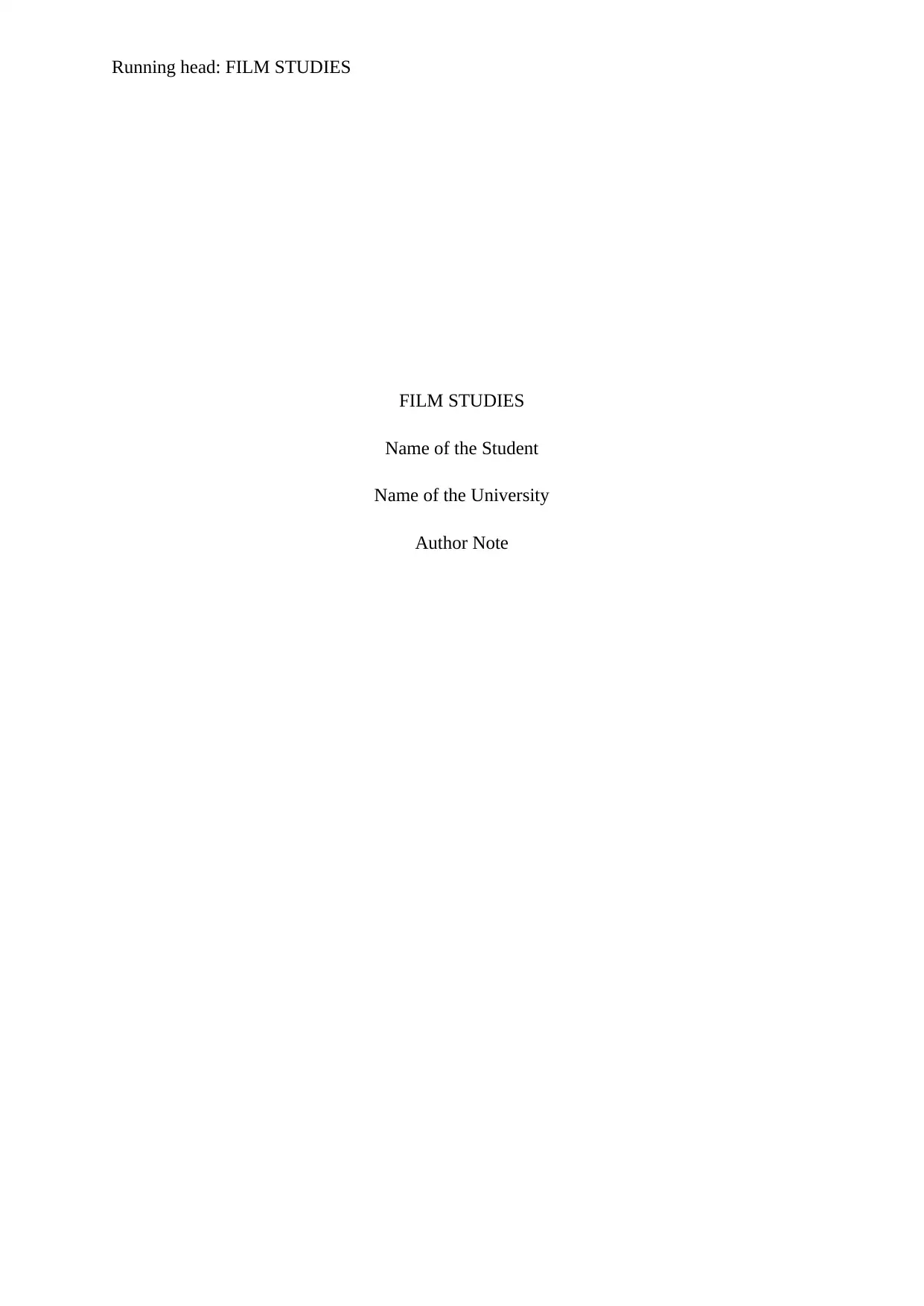
Running head: FILM STUDIES
FILM STUDIES
Name of the Student
Name of the University
Author Note
FILM STUDIES
Name of the Student
Name of the University
Author Note
Paraphrase This Document
Need a fresh take? Get an instant paraphrase of this document with our AI Paraphraser
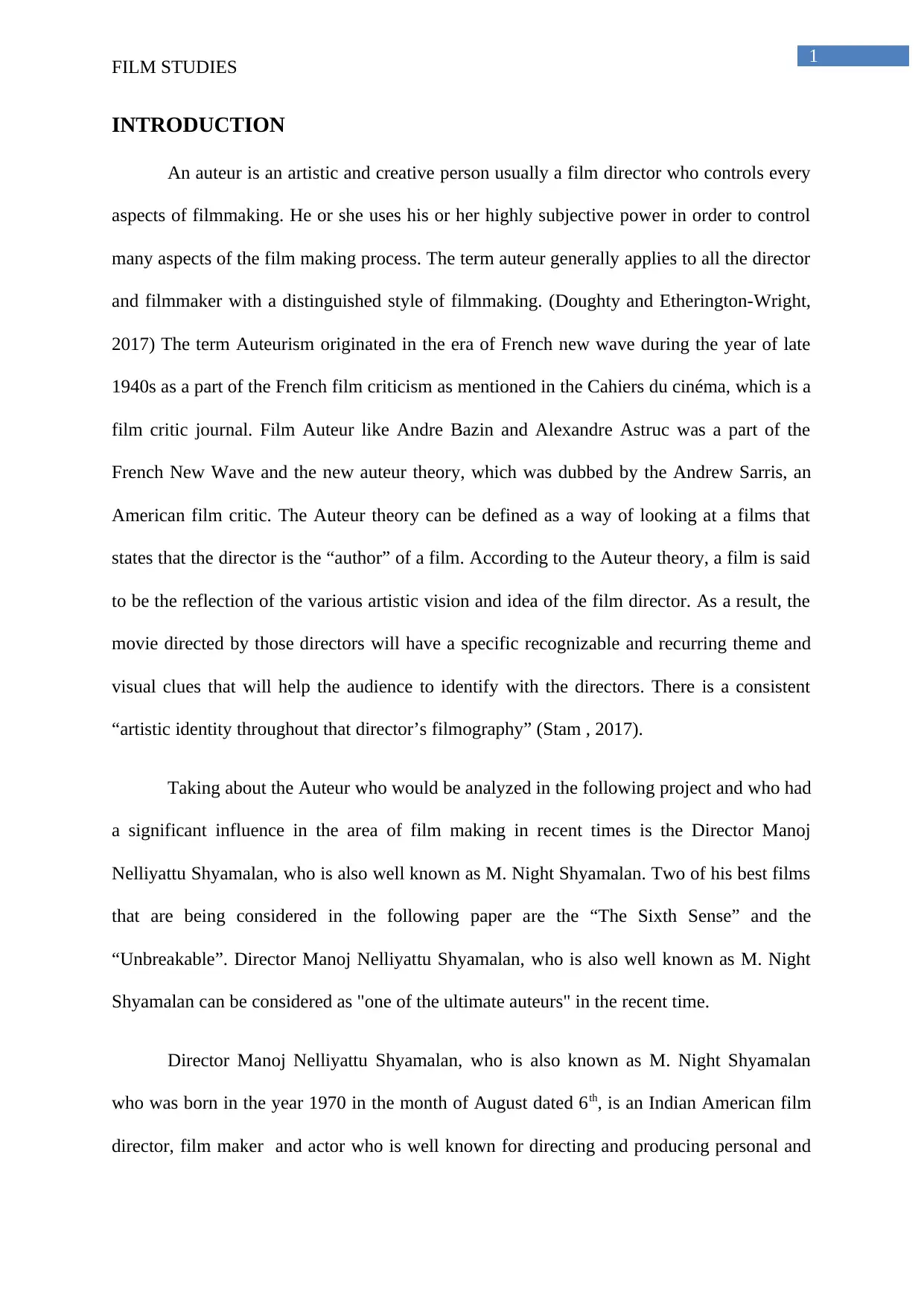
1
FILM STUDIES
INTRODUCTION
An auteur is an artistic and creative person usually a film director who controls every
aspects of filmmaking. He or she uses his or her highly subjective power in order to control
many aspects of the film making process. The term auteur generally applies to all the director
and filmmaker with a distinguished style of filmmaking. (Doughty and Etherington-Wright,
2017) The term Auteurism originated in the era of French new wave during the year of late
1940s as a part of the French film criticism as mentioned in the Cahiers du cinéma, which is a
film critic journal. Film Auteur like Andre Bazin and Alexandre Astruc was a part of the
French New Wave and the new auteur theory, which was dubbed by the Andrew Sarris, an
American film critic. The Auteur theory can be defined as a way of looking at a films that
states that the director is the “author” of a film. According to the Auteur theory, a film is said
to be the reflection of the various artistic vision and idea of the film director. As a result, the
movie directed by those directors will have a specific recognizable and recurring theme and
visual clues that will help the audience to identify with the directors. There is a consistent
“artistic identity throughout that director’s filmography” (Stam , 2017).
Taking about the Auteur who would be analyzed in the following project and who had
a significant influence in the area of film making in recent times is the Director Manoj
Nelliyattu Shyamalan, who is also well known as M. Night Shyamalan. Two of his best films
that are being considered in the following paper are the “The Sixth Sense” and the
“Unbreakable”. Director Manoj Nelliyattu Shyamalan, who is also well known as M. Night
Shyamalan can be considered as "one of the ultimate auteurs" in the recent time.
Director Manoj Nelliyattu Shyamalan, who is also known as M. Night Shyamalan
who was born in the year 1970 in the month of August dated 6th, is an Indian American film
director, film maker and actor who is well known for directing and producing personal and
FILM STUDIES
INTRODUCTION
An auteur is an artistic and creative person usually a film director who controls every
aspects of filmmaking. He or she uses his or her highly subjective power in order to control
many aspects of the film making process. The term auteur generally applies to all the director
and filmmaker with a distinguished style of filmmaking. (Doughty and Etherington-Wright,
2017) The term Auteurism originated in the era of French new wave during the year of late
1940s as a part of the French film criticism as mentioned in the Cahiers du cinéma, which is a
film critic journal. Film Auteur like Andre Bazin and Alexandre Astruc was a part of the
French New Wave and the new auteur theory, which was dubbed by the Andrew Sarris, an
American film critic. The Auteur theory can be defined as a way of looking at a films that
states that the director is the “author” of a film. According to the Auteur theory, a film is said
to be the reflection of the various artistic vision and idea of the film director. As a result, the
movie directed by those directors will have a specific recognizable and recurring theme and
visual clues that will help the audience to identify with the directors. There is a consistent
“artistic identity throughout that director’s filmography” (Stam , 2017).
Taking about the Auteur who would be analyzed in the following project and who had
a significant influence in the area of film making in recent times is the Director Manoj
Nelliyattu Shyamalan, who is also well known as M. Night Shyamalan. Two of his best films
that are being considered in the following paper are the “The Sixth Sense” and the
“Unbreakable”. Director Manoj Nelliyattu Shyamalan, who is also well known as M. Night
Shyamalan can be considered as "one of the ultimate auteurs" in the recent time.
Director Manoj Nelliyattu Shyamalan, who is also known as M. Night Shyamalan
who was born in the year 1970 in the month of August dated 6th, is an Indian American film
director, film maker and actor who is well known for directing and producing personal and
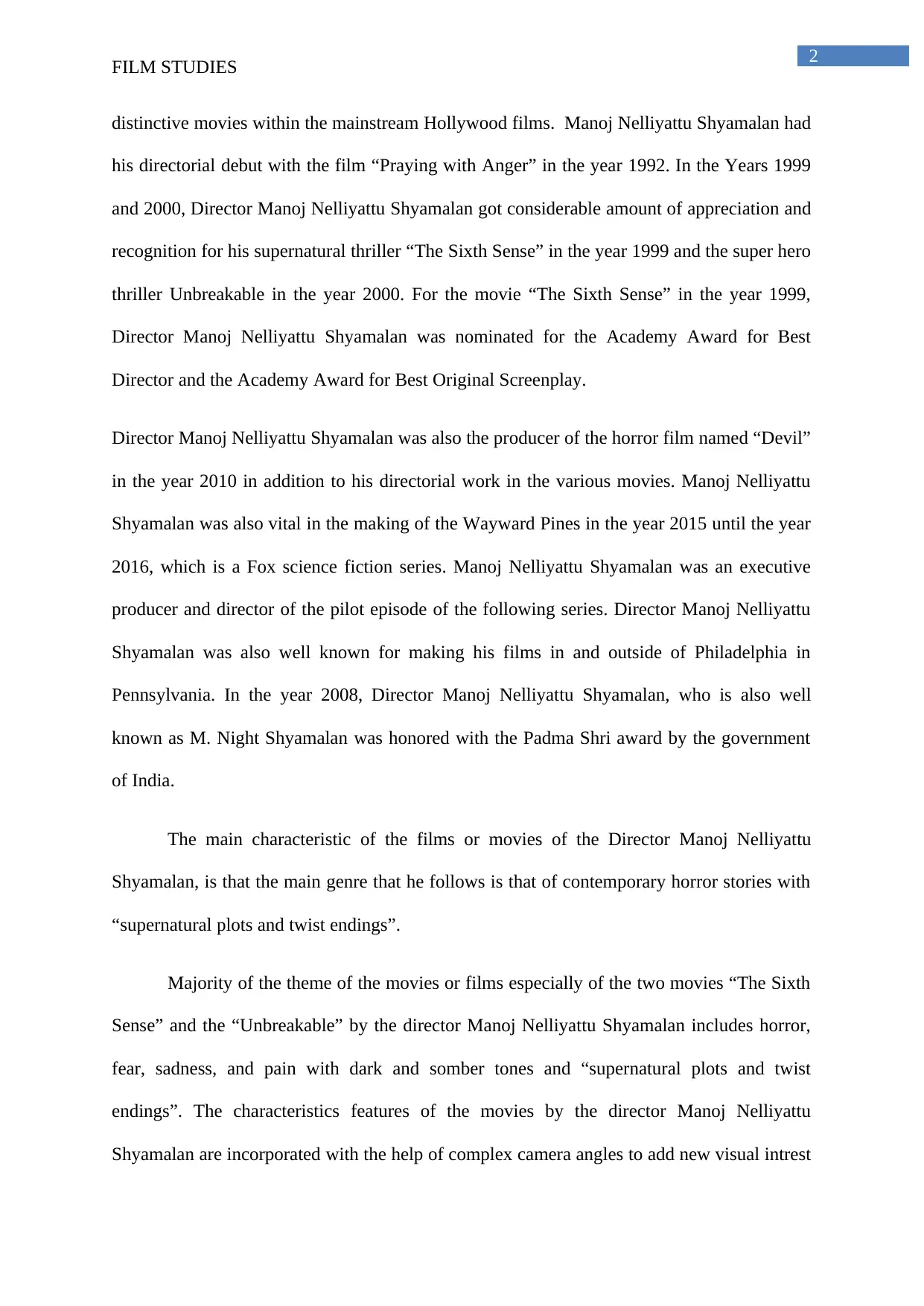
2
FILM STUDIES
distinctive movies within the mainstream Hollywood films. Manoj Nelliyattu Shyamalan had
his directorial debut with the film “Praying with Anger” in the year 1992. In the Years 1999
and 2000, Director Manoj Nelliyattu Shyamalan got considerable amount of appreciation and
recognition for his supernatural thriller “The Sixth Sense” in the year 1999 and the super hero
thriller Unbreakable in the year 2000. For the movie “The Sixth Sense” in the year 1999,
Director Manoj Nelliyattu Shyamalan was nominated for the Academy Award for Best
Director and the Academy Award for Best Original Screenplay.
Director Manoj Nelliyattu Shyamalan was also the producer of the horror film named “Devil”
in the year 2010 in addition to his directorial work in the various movies. Manoj Nelliyattu
Shyamalan was also vital in the making of the Wayward Pines in the year 2015 until the year
2016, which is a Fox science fiction series. Manoj Nelliyattu Shyamalan was an executive
producer and director of the pilot episode of the following series. Director Manoj Nelliyattu
Shyamalan was also well known for making his films in and outside of Philadelphia in
Pennsylvania. In the year 2008, Director Manoj Nelliyattu Shyamalan, who is also well
known as M. Night Shyamalan was honored with the Padma Shri award by the government
of India.
The main characteristic of the films or movies of the Director Manoj Nelliyattu
Shyamalan, is that the main genre that he follows is that of contemporary horror stories with
“supernatural plots and twist endings”.
Majority of the theme of the movies or films especially of the two movies “The Sixth
Sense” and the “Unbreakable” by the director Manoj Nelliyattu Shyamalan includes horror,
fear, sadness, and pain with dark and somber tones and “supernatural plots and twist
endings”. The characteristics features of the movies by the director Manoj Nelliyattu
Shyamalan are incorporated with the help of complex camera angles to add new visual intrest
FILM STUDIES
distinctive movies within the mainstream Hollywood films. Manoj Nelliyattu Shyamalan had
his directorial debut with the film “Praying with Anger” in the year 1992. In the Years 1999
and 2000, Director Manoj Nelliyattu Shyamalan got considerable amount of appreciation and
recognition for his supernatural thriller “The Sixth Sense” in the year 1999 and the super hero
thriller Unbreakable in the year 2000. For the movie “The Sixth Sense” in the year 1999,
Director Manoj Nelliyattu Shyamalan was nominated for the Academy Award for Best
Director and the Academy Award for Best Original Screenplay.
Director Manoj Nelliyattu Shyamalan was also the producer of the horror film named “Devil”
in the year 2010 in addition to his directorial work in the various movies. Manoj Nelliyattu
Shyamalan was also vital in the making of the Wayward Pines in the year 2015 until the year
2016, which is a Fox science fiction series. Manoj Nelliyattu Shyamalan was an executive
producer and director of the pilot episode of the following series. Director Manoj Nelliyattu
Shyamalan was also well known for making his films in and outside of Philadelphia in
Pennsylvania. In the year 2008, Director Manoj Nelliyattu Shyamalan, who is also well
known as M. Night Shyamalan was honored with the Padma Shri award by the government
of India.
The main characteristic of the films or movies of the Director Manoj Nelliyattu
Shyamalan, is that the main genre that he follows is that of contemporary horror stories with
“supernatural plots and twist endings”.
Majority of the theme of the movies or films especially of the two movies “The Sixth
Sense” and the “Unbreakable” by the director Manoj Nelliyattu Shyamalan includes horror,
fear, sadness, and pain with dark and somber tones and “supernatural plots and twist
endings”. The characteristics features of the movies by the director Manoj Nelliyattu
Shyamalan are incorporated with the help of complex camera angles to add new visual intrest
⊘ This is a preview!⊘
Do you want full access?
Subscribe today to unlock all pages.

Trusted by 1+ million students worldwide
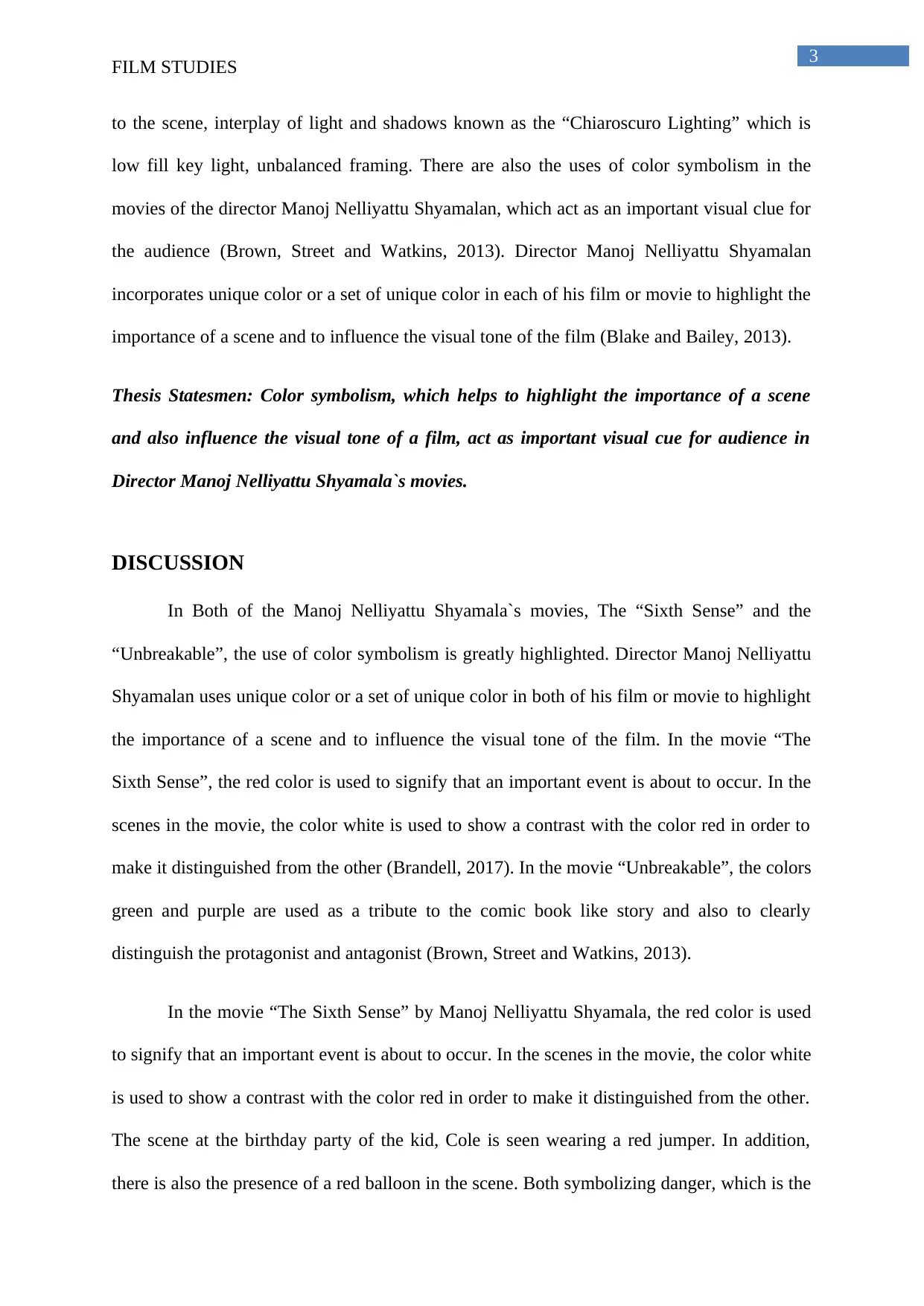
3
FILM STUDIES
to the scene, interplay of light and shadows known as the “Chiaroscuro Lighting” which is
low fill key light, unbalanced framing. There are also the uses of color symbolism in the
movies of the director Manoj Nelliyattu Shyamalan, which act as an important visual clue for
the audience (Brown, Street and Watkins, 2013). Director Manoj Nelliyattu Shyamalan
incorporates unique color or a set of unique color in each of his film or movie to highlight the
importance of a scene and to influence the visual tone of the film (Blake and Bailey, 2013).
Thesis Statesmen: Color symbolism, which helps to highlight the importance of a scene
and also influence the visual tone of a film, act as important visual cue for audience in
Director Manoj Nelliyattu Shyamala`s movies.
DISCUSSION
In Both of the Manoj Nelliyattu Shyamala`s movies, The “Sixth Sense” and the
“Unbreakable”, the use of color symbolism is greatly highlighted. Director Manoj Nelliyattu
Shyamalan uses unique color or a set of unique color in both of his film or movie to highlight
the importance of a scene and to influence the visual tone of the film. In the movie “The
Sixth Sense”, the red color is used to signify that an important event is about to occur. In the
scenes in the movie, the color white is used to show a contrast with the color red in order to
make it distinguished from the other (Brandell, 2017). In the movie “Unbreakable”, the colors
green and purple are used as a tribute to the comic book like story and also to clearly
distinguish the protagonist and antagonist (Brown, Street and Watkins, 2013).
In the movie “The Sixth Sense” by Manoj Nelliyattu Shyamala, the red color is used
to signify that an important event is about to occur. In the scenes in the movie, the color white
is used to show a contrast with the color red in order to make it distinguished from the other.
The scene at the birthday party of the kid, Cole is seen wearing a red jumper. In addition,
there is also the presence of a red balloon in the scene. Both symbolizing danger, which is the
FILM STUDIES
to the scene, interplay of light and shadows known as the “Chiaroscuro Lighting” which is
low fill key light, unbalanced framing. There are also the uses of color symbolism in the
movies of the director Manoj Nelliyattu Shyamalan, which act as an important visual clue for
the audience (Brown, Street and Watkins, 2013). Director Manoj Nelliyattu Shyamalan
incorporates unique color or a set of unique color in each of his film or movie to highlight the
importance of a scene and to influence the visual tone of the film (Blake and Bailey, 2013).
Thesis Statesmen: Color symbolism, which helps to highlight the importance of a scene
and also influence the visual tone of a film, act as important visual cue for audience in
Director Manoj Nelliyattu Shyamala`s movies.
DISCUSSION
In Both of the Manoj Nelliyattu Shyamala`s movies, The “Sixth Sense” and the
“Unbreakable”, the use of color symbolism is greatly highlighted. Director Manoj Nelliyattu
Shyamalan uses unique color or a set of unique color in both of his film or movie to highlight
the importance of a scene and to influence the visual tone of the film. In the movie “The
Sixth Sense”, the red color is used to signify that an important event is about to occur. In the
scenes in the movie, the color white is used to show a contrast with the color red in order to
make it distinguished from the other (Brandell, 2017). In the movie “Unbreakable”, the colors
green and purple are used as a tribute to the comic book like story and also to clearly
distinguish the protagonist and antagonist (Brown, Street and Watkins, 2013).
In the movie “The Sixth Sense” by Manoj Nelliyattu Shyamala, the red color is used
to signify that an important event is about to occur. In the scenes in the movie, the color white
is used to show a contrast with the color red in order to make it distinguished from the other.
The scene at the birthday party of the kid, Cole is seen wearing a red jumper. In addition,
there is also the presence of a red balloon in the scene. Both symbolizing danger, which is the
Paraphrase This Document
Need a fresh take? Get an instant paraphrase of this document with our AI Paraphraser
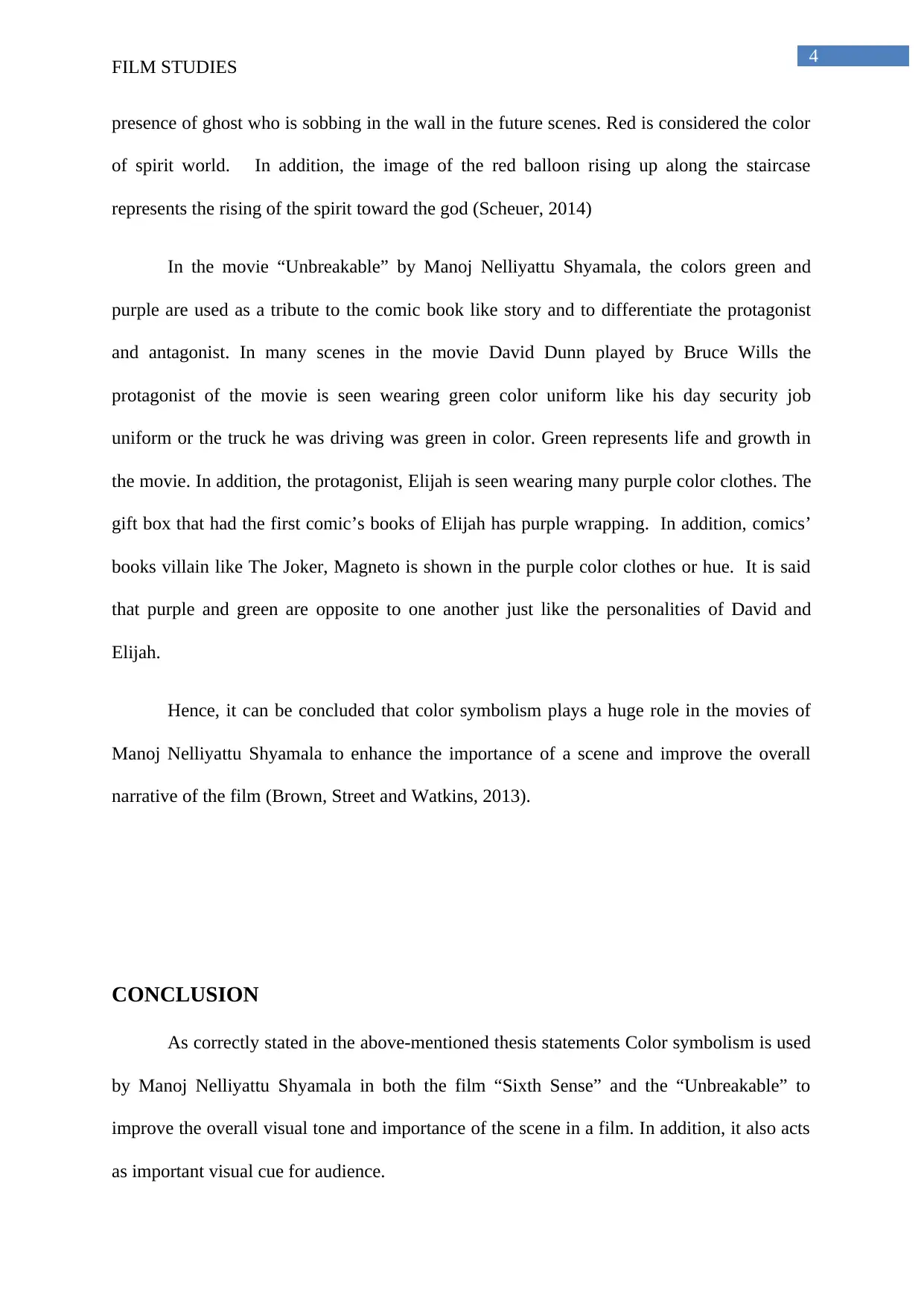
4
FILM STUDIES
presence of ghost who is sobbing in the wall in the future scenes. Red is considered the color
of spirit world. In addition, the image of the red balloon rising up along the staircase
represents the rising of the spirit toward the god (Scheuer, 2014)
In the movie “Unbreakable” by Manoj Nelliyattu Shyamala, the colors green and
purple are used as a tribute to the comic book like story and to differentiate the protagonist
and antagonist. In many scenes in the movie David Dunn played by Bruce Wills the
protagonist of the movie is seen wearing green color uniform like his day security job
uniform or the truck he was driving was green in color. Green represents life and growth in
the movie. In addition, the protagonist, Elijah is seen wearing many purple color clothes. The
gift box that had the first comic’s books of Elijah has purple wrapping. In addition, comics’
books villain like The Joker, Magneto is shown in the purple color clothes or hue. It is said
that purple and green are opposite to one another just like the personalities of David and
Elijah.
Hence, it can be concluded that color symbolism plays a huge role in the movies of
Manoj Nelliyattu Shyamala to enhance the importance of a scene and improve the overall
narrative of the film (Brown, Street and Watkins, 2013).
CONCLUSION
As correctly stated in the above-mentioned thesis statements Color symbolism is used
by Manoj Nelliyattu Shyamala in both the film “Sixth Sense” and the “Unbreakable” to
improve the overall visual tone and importance of the scene in a film. In addition, it also acts
as important visual cue for audience.
FILM STUDIES
presence of ghost who is sobbing in the wall in the future scenes. Red is considered the color
of spirit world. In addition, the image of the red balloon rising up along the staircase
represents the rising of the spirit toward the god (Scheuer, 2014)
In the movie “Unbreakable” by Manoj Nelliyattu Shyamala, the colors green and
purple are used as a tribute to the comic book like story and to differentiate the protagonist
and antagonist. In many scenes in the movie David Dunn played by Bruce Wills the
protagonist of the movie is seen wearing green color uniform like his day security job
uniform or the truck he was driving was green in color. Green represents life and growth in
the movie. In addition, the protagonist, Elijah is seen wearing many purple color clothes. The
gift box that had the first comic’s books of Elijah has purple wrapping. In addition, comics’
books villain like The Joker, Magneto is shown in the purple color clothes or hue. It is said
that purple and green are opposite to one another just like the personalities of David and
Elijah.
Hence, it can be concluded that color symbolism plays a huge role in the movies of
Manoj Nelliyattu Shyamala to enhance the importance of a scene and improve the overall
narrative of the film (Brown, Street and Watkins, 2013).
CONCLUSION
As correctly stated in the above-mentioned thesis statements Color symbolism is used
by Manoj Nelliyattu Shyamala in both the film “Sixth Sense” and the “Unbreakable” to
improve the overall visual tone and importance of the scene in a film. In addition, it also acts
as important visual cue for audience.

5
FILM STUDIES
FILM STUDIES
⊘ This is a preview!⊘
Do you want full access?
Subscribe today to unlock all pages.

Trusted by 1+ million students worldwide
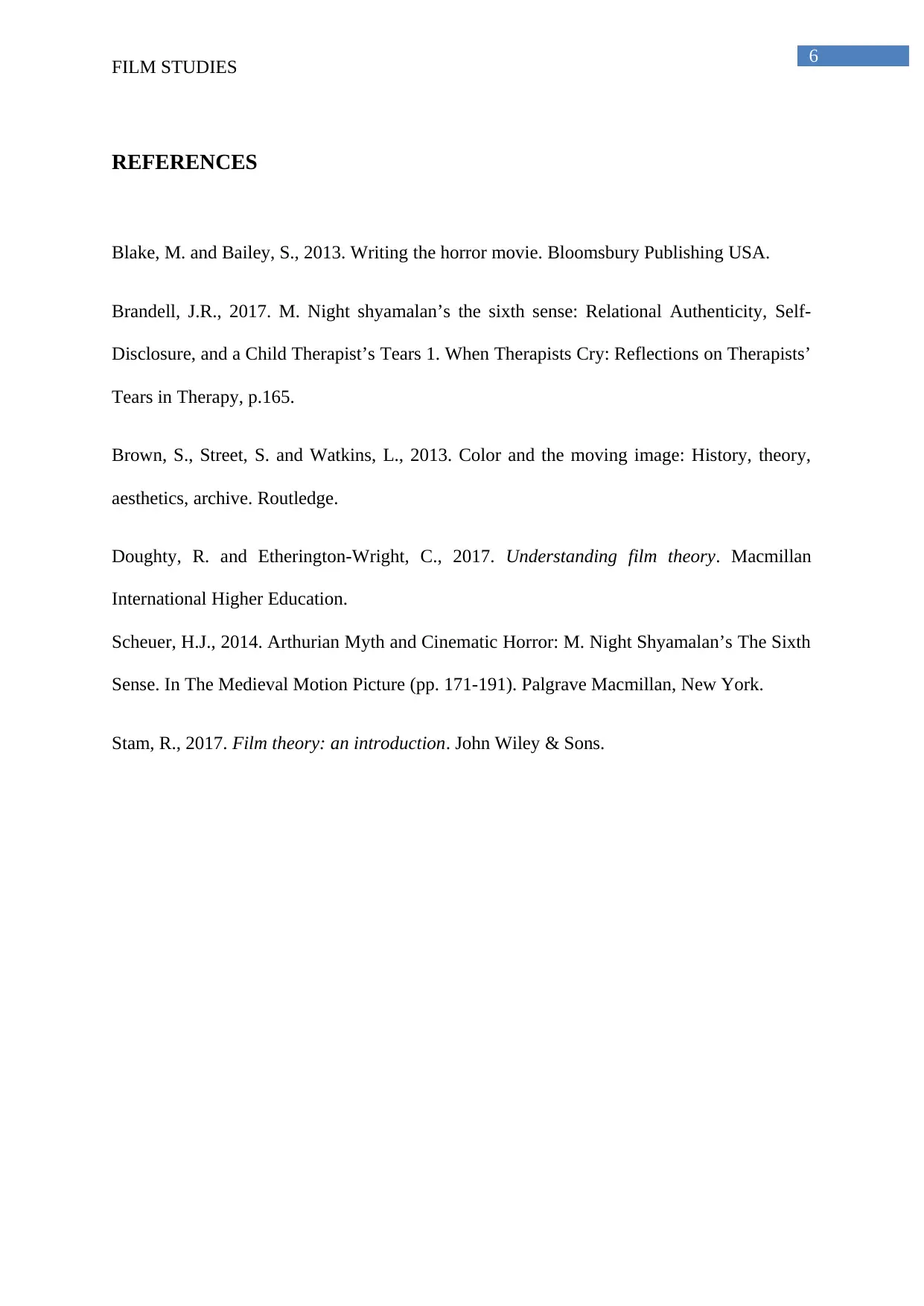
6
FILM STUDIES
REFERENCES
Blake, M. and Bailey, S., 2013. Writing the horror movie. Bloomsbury Publishing USA.
Brandell, J.R., 2017. M. Night shyamalan’s the sixth sense: Relational Authenticity, Self-
Disclosure, and a Child Therapist’s Tears 1. When Therapists Cry: Reflections on Therapists’
Tears in Therapy, p.165.
Brown, S., Street, S. and Watkins, L., 2013. Color and the moving image: History, theory,
aesthetics, archive. Routledge.
Doughty, R. and Etherington-Wright, C., 2017. Understanding film theory. Macmillan
International Higher Education.
Scheuer, H.J., 2014. Arthurian Myth and Cinematic Horror: M. Night Shyamalan’s The Sixth
Sense. In The Medieval Motion Picture (pp. 171-191). Palgrave Macmillan, New York.
Stam, R., 2017. Film theory: an introduction. John Wiley & Sons.
FILM STUDIES
REFERENCES
Blake, M. and Bailey, S., 2013. Writing the horror movie. Bloomsbury Publishing USA.
Brandell, J.R., 2017. M. Night shyamalan’s the sixth sense: Relational Authenticity, Self-
Disclosure, and a Child Therapist’s Tears 1. When Therapists Cry: Reflections on Therapists’
Tears in Therapy, p.165.
Brown, S., Street, S. and Watkins, L., 2013. Color and the moving image: History, theory,
aesthetics, archive. Routledge.
Doughty, R. and Etherington-Wright, C., 2017. Understanding film theory. Macmillan
International Higher Education.
Scheuer, H.J., 2014. Arthurian Myth and Cinematic Horror: M. Night Shyamalan’s The Sixth
Sense. In The Medieval Motion Picture (pp. 171-191). Palgrave Macmillan, New York.
Stam, R., 2017. Film theory: an introduction. John Wiley & Sons.
1 out of 7
Your All-in-One AI-Powered Toolkit for Academic Success.
+13062052269
info@desklib.com
Available 24*7 on WhatsApp / Email
![[object Object]](/_next/static/media/star-bottom.7253800d.svg)
Unlock your academic potential
Copyright © 2020–2025 A2Z Services. All Rights Reserved. Developed and managed by ZUCOL.